
A skewer is a thin metal or wood stick used to hold pieces of food together. The word may sometimes be used as a metonym, to refer to the entire food item served on a skewer, as in "chicken skewers". Skewers are used while grilling or roasting meats and fish, and in other culinary applications.
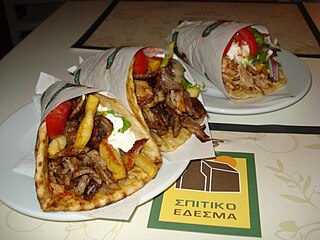
Gyros, sometimes anglicized as a gyro in some regions, is meat cooked on a vertical rotisserie, then sliced and served wrapped or stuffed in pita bread, along with other ingredients such as tomato, onion, fried potatoes, and tzatziki. In Greece, it is normally made with pork or sometimes with chicken, whilst beef and lamb are also used in other countries.

Kebab, kabob, or kebap or kabab is roasted meat that originates from the Middle East and has been popularised by Iranian cuisine & Turkish cuisine. Many variants of the category are popular around the world, including the skewered shish kebab and the doner kebab with bread.

Shawarma is a Middle Eastern dish that originated in the Levant region of the Arab world during the Ottoman Empire, consisting of meat cut into thin slices, stacked in an inverted cone, and roasted on a slowly turning vertical rotisserie or spit. Traditionally made with lamb or mutton, it may also be made with chicken, beef or veal. Thin slices are shaved off the cooked surface as it continuously rotates. Shawarma is a popular street food throughout the Arab world and the Greater Middle East.
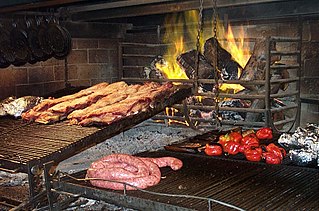
Asado is the technique and the social event of having or attending a barbecue in various South American countries, especially Argentina, Chile, Paraguay, Peru and Uruguay where it is also a traditional event. An asado usually consists of beef, pork, chicken, chorizo, and morcilla, all of which are cooked using an open fire or a grill, called a parrilla. Usually, red wine and side dishes such as salads accompany the main meats, which are prepared by a designated cook called the asador or parrillero.

Roast chicken is chicken prepared as food by roasting whether in a home kitchen, over a fire, or with a rotisserie. Generally, the chicken is roasted with its own fat and juices by circulating the meat during roasting, and therefore, are usually cooked exposed to fire or heat with some type of rotary grill so that the circulation of these fats and juices is as efficient as possible. Roast chicken is a dish that appears in a wide variety of cuisines worldwide.

Rotisserie, also known as spit-roasting, is a style of roasting where meat is skewered on a spit – a long, solid rod used to hold food while it is being cooked over a fire in a fireplace or over a campfire, or roasted in an oven. This method is generally used for cooking large joints of meat or entire animals, such as pigs or turkeys. The rotation cooks the meat evenly in its own juices and allows easy access for continuous basting.

Doner kebab, also spelled as döner kebab, is a dish of Turkish origin made of meat cooked on a vertical rotisserie. Seasoned meat stacked in the shape of an inverted cone is turned slowly on the rotisserie, next to a vertical cooking element. The operator uses a knife to slice thin shavings from the outer layer of the meat as it cooks. The vertical rotisserie was invented in the 19th-century Ottoman Empire, and dishes such as the Arab shawarma, Greek gyros, Canadian donair, and Mexican al pastor are derived from this.
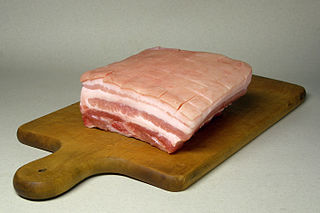
Pork belly or belly pork is a boneless and fatty cut of meat from the belly of a pig. Pork belly is particularly popular in Filipino, Hispanic, Chinese, Danish, Norwegian, Korean, and Thai cuisine.

Levantine cuisine is the traditional cuisine of the Levant, in the sense of the rough area of former Ottoman Syria. The cuisine has similarities with Egyptian cuisine, North African cuisine and Ottoman cuisine. It is particularly known for its meze spreads of hot and cold dishes, most notably among them ful medames, hummus, tabbouleh and baba ghanoush, accompanied by bread.
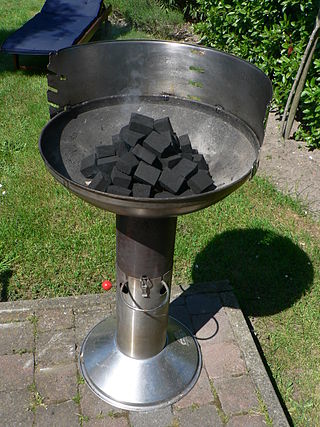
Barbecue varies by the type of meat, sauce, rub, or other flavorings used, the point in barbecuing at which they are added, the role smoke plays, the equipment and fuel used, cooking temperature, and cooking time.

Siu mei is the generic Cantonese name of meats roasted on spits over an open fire or a large wood-burning rotisserie oven. It creates a unique, deep barbecue flavor and the roast is usually coated with a flavorful sauce before roasting. Siu mei is very popular in Hong Kong and Macau, and overseas Chinatowns especially with Cantonese emigrants. In Hong Kong, the average person eats siu mei once every four days, with char siu being the most popular, followed by siu yuk in second, and roast goose being third. Some siu mei such as white cut chicken and soy sauce chicken are not roasted at all but they are still considered siu mei nonetheless. siu mei is also known colloquially as siu laap, as the latter term encompasses siu mei and laap mei, a type of preserved meat. They are usually prepared in the same kitchen during autumn and winter season in what are often known as siu laap establishments or Chinese BBQ shops. Siu laap is also often sold alongside lou mei, such as orange cuttlefish and Pig's ear.
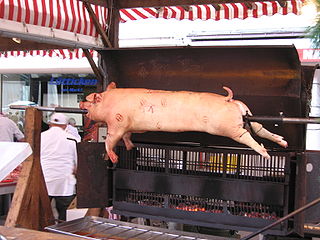
A pig roast or hog roast is an event or gathering which involves the barbecuing of a whole pig.

Inihaw, also known as sinugba or inasal, are various types of grilled or pit-roasted barbecue dishes from the Philippines. They are usually made from pork or chicken and are served on bamboo skewers or in small cubes with a soy sauce and vinegar-based dip. The term can also refer to any meat or seafood dish cooked and served in a similar way. Inihaw are commonly sold as street food and are eaten with white rice or rice cooked in coconut leaves (pusô). Inihaw is also commonly referred to as Filipino barbecue or (informally) Pinoy BBQ.

Meat plays a much more dominant role in Pakistani cuisine, compared to other South Asian cuisines. Of all the meats, the most popular are chicken, lamb, beef, goat, and fish.Beef is particularly sought after as the meat of choice for kebab dishes or the classic beef shank dish nihari. Seafood is generally not consumed in large amounts, though it is very popular in the coastal areas of Sindh and the Makran coast of Balochistan.
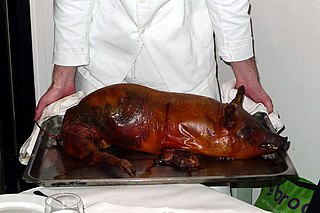
A suckling pig is a piglet fed on its mother's milk. In culinary contexts, a suckling pig is slaughtered between the ages of two and six weeks. It is traditionally cooked whole, often roasted, in various cuisines. It is usually prepared for special occasions and gatherings. The most popular preparation can be found in Spain and Portugal under the name lechón (Spanish) or leitão (Portuguese).



























